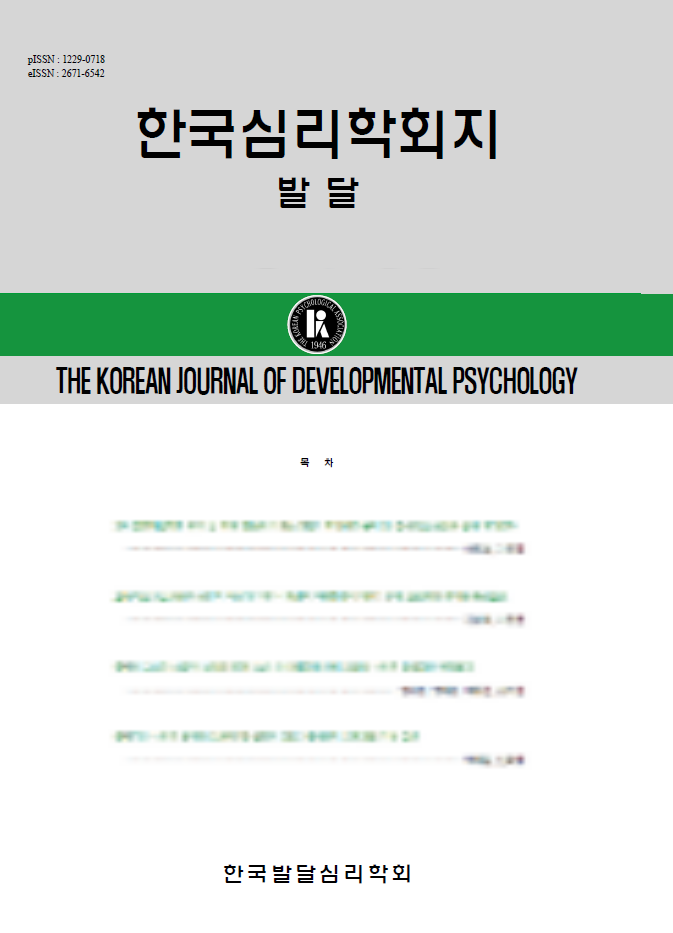open access
메뉴
open access
메뉴 ISSN : 1229-0718
ISSN : 1229-0718
본 연구는 코로나19 유행시기에 한국과 중국 어머니의 양육환경과 양육스트레스가 유아의 불안에 영향을 미치는지 검증하고자 하였다. 연구대상은 유아기 자녀가 있는 한국 어머니 135명과 중국 어머니 208명이었다. 연구자료는 SPSS 21.0을 이용하여 빈도분석, 독립 t검증, 상관분석, 다중회귀 분석을 시행하였다. 주요 연구결과는 첫째, 한국과 중국 어머니 모두 코로나19 유행시기에 자녀를 양육하는 시간이 증가하였고, 그 이유로는 자녀들의 교육기관이 휴원이라고 응답한 비율이 가장 높았다. 둘째, 코로나19 유행시기 동안 한국 어머니의 양육스트레스가 중국 어머니보다 유의하게 높은 것으로 나타났다. 마지막으로 한국 어머니의 자가격리 경험, 코로나19 확진자 수, 양육스트레스는 한국 유아의 불안을 설명하는 변인이었고, 중국 어머니의 양육스트레스는 중국 유아의 불안을 유의하게 설명하였다. 본 연구는 코로나19 유행시기 어머니들이 처한 양육환경을 살펴보고, 유아들의 불안에 영향을 미칠 수 있는 요인에 대한 정보를 제공했다는 점에 의의가 있다.
This study aimed to examine the effects of Korean and Chinese mothers' parenting environment and parenting stress on children's anxiety during the COVID-19 pandemic. The study participants were 135 Korean mothers and 209 Chinese mothers of children aged 3-5 years old. Frequency, correlation, and multiple regression analyses were performed using SPSS 21.0. First, Korean and Chinese mothers reported that their parenting time increased during the COVID-19 due to the closure of children's educational institutions. Second, Korean mothers' parenting stress was significantly higher than Chinese mothers. Finally, for Korean mothers, the experience of self-quarantine, confirmed cases in the family, and parenting stress were significant variables on the children's anxiety. Chinese mothers' parenting stress affected the Chinese children's anxiety. This study provides information about the parenting environment during the COVID-19 pandemic and the factors that could affect children's anxiety.
본 연구는 가정의 사회경제적지위(SES)와 부모-자녀 간 상호작용이 학령전기 수용 및 표현어휘력과 학령기 어휘적용력, 언어유추력, 집행기능을 유의하게 예측하는지 검토하였다. 본 연구에서는 한국아동패널에서 공개한 6차년도(2013년, T1) 및 9차년도(2016년, T2) 데이터를 사용하였으며, 6차년도 당시 만 5세였던 아동 318명의 데이터를 2개 시점에서 분석하였다. 월평균 가구 소득 및 부/모의 최종학력 데이터로 SES를 산출하였으며, 부모-자녀 상호작용, 수용・표현어휘력 검사, 다요인 지능검사의 어휘적용력과 언어유추력, 그리고 집행기능곤란 데이터를 분석의 대상으로 하였다. SES, 부모-자녀 간 상호작용을 예측변인으로 한 위계적 중다회귀분석 결과, T1에서 수용어휘력은 SES와 부모-자녀 간 상호작용 모두 유의한 설명력을 갖지 못하였으며, 표현어휘력은 두 변인 모두 유의한 설명 변인인 것으로 나타났다. T2에서 언어유추력은 SES와 부모-자녀 간 상호작용 모두 유의한 설명력을 가졌으나, 어휘적용력과 집행기능은 SES만이 유의한 설명 변인이었다. 본 연구는 부모-자녀 간 상호작용이 아동들의 일부 언어능력에 대해 SES 외에 추가적인 설명력을 가짐을 확인하였으며, 이러한 결과는 SES가 낮은 가정에서 풍부한 부모-자녀 상호작용이 언어능력의 격차를 해소하는 데에 도움을 줄 수 있음을 시사한다.
This cross-sectional, longitudinal study aimed to investigate the predictive effects of SES and parent-child interaction on children's language skills and executive function. We analyzed the data of 318 children (M=62.28 months, SD=1.22) from 2013 (T1) and 2016 (T2) from Panel Study of Korean Children (PSKC). Hierarchical multiple linear regression analyses were conducted to examine the effects of the predictor variables on vocabulary scores at T1, and word application, verbal reasoning, and executive function at T2. Results revealed that SES and parent-child interaction were significant predictors of expressive but not receptive vocabulary at T1. Only SES predicted word application and executive function at T2, but both variables predicted verbal reasoning. This study revealed parent-child interaction’s essential factor along with SES predicting children's language skills and executive function. Hence, rich parent-child interaction in low-SES homes could aid in bridging the gap brought on by SES.
인과관계 추론이란 두 물체나 사건 사이의 원인과 결과의 관계를 파악하는 것으로, 인과관계에 기초하여 현상들을 설명하고 예측하는 것에 기반을 두고 있기에 인과관계를 추론하고 이해하는 것은 세상을 살아가는 데 있어서 전 영역에 걸쳐 매우 중요한 사고 능력이다. 이러한 인과추론 능력은 언제부터 출현하기 시작하여 어떠한 양상으로 발달하는 것일까? 인과추론 발달 과정은 보편적 양상을 따를까? 이 과정에서 언어나 사회문화적 요인은 인과추론 발달의 다양성을 유도할 수 있을까? 본 연구는 이러한 질문을 탐색해보기 위해 발달 초기에서 아동기까지 축적된 국내외 인과관계 추론 발달 관련 연구를 검토하였다. 검토 결과, 아동기 초기의 발달 양상이 미국, 중국, 인도와 한국에서 보편적이기보다 다양하게 진행될 가능성이 나타났다. 그리고 언어나 사회문화적 요인이 발달의 다양성을 유발할 가능성도 있었다. 그러나 현재까지 관련된 근거 자료들은 제한적이었고, 국내의 연구도 과거 미국 자료의 반복 검증 위주로 매우 제한적이었던 것으로 나타났다. 인과관계 추론능력 발달에서의 보편성과 다양성의 추가적 검토를 위해 한국 아동 연구가 가진 역할을 살펴보고 추후 연구의 방향성을 제언하였다.
Causal relational reasoning is the ability to make abstract inferences about causal relationships among objects or events and is one of the most important thought processes that allow individuals to draw and acquire various forms of knowledge. The current review analyzed research that examined the early development of causal relational reasoning across different cultures, including research conducted in Korea in this domain. In particular, we examined whether the developmental pathway of causal relational reasoning is universal or diverse across cultures and the possible role of language and/or sociocultural factors. Developmental patterns that appeared around age three differed across the U.S., China, India, and Korea, possibly attributable to diverse language acquisition patterns and cultural contexts. However, no definitive conclusions could be drawn from the current data because of the limited evidence available. Research conducted in Korea has also been limited to replications of past studies. Suggestions were made for future studies of Korean toddlers and children that could help further verify the developmental pattern of causal relational reasoning.